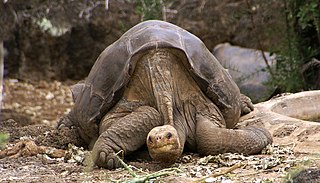
Shed a tear, if you will for Lonesome George, age unknown but around a hundred, who passed away yesterday in his home in the Galapagos Islands. George was a Pinta Island tortoise (Chelonoidis nigra abingdoni), the last known specimen of his kind. He was found on Pinta Island in 1971, and relocated for his own safety to a pen in a national park. Attempts to mate him with females of closely related subspecies were, not too unsurprisingly, unsuccessful.
Why should you care about George? After all, he was just a turtle, albeit a famous, well-loved, 200-pound turtle. He wasn’t even particularly handsome, even for a turtle. If I can’t convince you that an obscure subspecies of turtle is important, or that George was a living creature, and as such deserves just a smidgen of respect, perhaps you’ll agree that George can stand as a symbol for a lot of last-of-his-kind animals to whom we’ve bade farewell. In 1914, the last passenger pigeon, called Martha, died in the Cincinnati Zoo (not bad enough that she was the last of her kind, but she also had to spend her waning years in Cincinnati). Benjamin, the last thylacine (a marsupial wolf-like creature) died in the Hobart Zoo in Tasmania in 1936. Saddest (to a grouse researcher like me) was Booming Ben, the last-of-his-kind heath hen, who died in Martha’s Vineyard after spending his last four years calling in vain for a mate. His cause of death is officially unknown, but you and I know that he died of a broken heart. What happened to these animals? Why did they disappear? Some will suggest that they lost in the big game of evolution, that they were unable to adapt and so vanished, and rightly so. Don’t you believe it. In the 1700s and 1800s, passenger pigeons may have been the most numerous animal on earth. During colonial times, heath hens were so common that people looking for work would bargain with prospective employers to have an upper limit on the number of times per week they could be fed the tasty birds. Other now-extinct animals, such as Carolina parakeets and great auks, leave behind similar stories of their prodigious numbers. These animals, and others like them, had existed for tens or hundreds of thousands of years in immense populations. What happened to them was us. Human interference, beginning with our first ancestors to stumble out of Africa, changed the habitats where these animals spent uncounted eons evolving. Thylacines were hunted out of existence beginning with the first few people who landed in Australia. Heath hens depended on (wait for it…) heaths; as these were converted to cropland and cities, the birds had no place to do their elaborate mating dances. Passenger pigeons may have been doomed by the destruction of a single large forest where the bulk of the population reproduced. George’s Pinta Island tortoises were condemned when feral goats destroyed the native vegetation on his island. We have hunted, harassed, poisoned, and shot hundreds of species out of existence. We’ve destroyed innumerable acres of habitat, converting it to croplands, or grazing land, or Wal-Mart parking lots. Where we haven’t outright destroyed habitat, we’ve fragmented it into uselessness, or polluted it with pesticides, or introduced pests, parasites, competitors, or predators that don’t belong where we’ve put them. The coup de grace may well be climate change; as the earth warms animals are forced north, or to higher elevations, and there’s only so far up an animal can go, and he can’t take the plants he needs with him. Again, what do you care? Aren’t we doing just fine without heath hens and ivory-bills? Doesn’t my car run just fine without any help from Steller’s sea cows? What does a golden toad have to do with me? Honestly, the last Chaco azul pupfish probably died without impacting you negatively. But we can’t really be sure. It turns out that the environment is made up of millions of species all linked together in complex webs of interdependence that ecologists are only beginning to understand. Perhaps you could think of the ecosystem as a huge Jenga game, and we’ve pulled out an awful lot of pieces. And there are a lot of pieces just on the verge of being pulled out. A quarter of the world’s birds are considered threatened or endangered. That doesn’t mean that three-quarters are in good shape, either; for many species of birds, nobody has studied whether or not their populations are stable. Reptiles, mammals, and especially amphibians are in similar straits. So, this evening, drink a toast to George, the last of his kind. But not the last last-of-his-kind that we’ll hear about.
